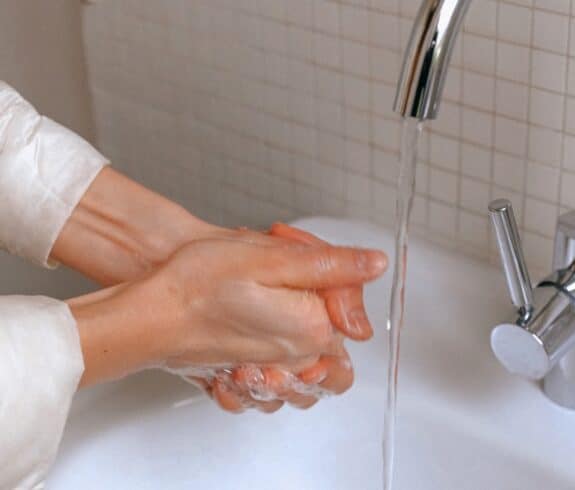In recent years, hand sanitizer has become a ubiquitous tool in the battle against viruses, germs, and bacteria. Whether you’re commuting on public transportation, traveling, or just going about your day-to-day routine, hand sanitizer is often seen as an essential item to quickly ‘clean’ your hands of any viruses you may have picked up. However, while hand sanitizer can certainly be effective in killing germs and preventing the spread of illnesses, it also comes with a number of potential risks and hazards. As a mom, I wanted to take a closer look at the dangers of hand sanitizer and explore some natural alternatives to chemical-based products.
When you take a broad look at the risks associated with hand sanitizer use one of the biggest concerns is the use of toxic chemicals. Hand sanitizers often contain ingredients like triclosan, phthalates, parabens, and propylene glycol, which can be harmful to human health. Additionally, frequent use of hand sanitizer can lead to skin irritation, dryness, and cracking. I have noticed this personally and have been opting for soap and water whenever possible to help clear it up.
Furthermore, regular exposure to hand sanitizer can weaken the immune system and increase the risk of antibiotic resistance. These short- and long-term health risks are important to keep in mind when using hand sanitizers.
Types of Hand Sanitizers and Their Potential Risks
It’s important to note that not all hand sanitizers are created equal. There are two main types of hand sanitizers: alcohol-based and alcohol-free. While alcohol-based sanitizers are generally considered to be more effective in killing germs, they may also be more drying to the skin. Additionally, some alcohol-based sanitizers contain a high percentage of alcohol, which can be flammable and pose a fire hazard. Studies have found that hand sanitizers with less than 60% alcohol or alcohol-free sanitizers containing quaternary ammonium compounds or benzalkonium chloride may not be as effective in killing all types of bacteria.
The Short-Term Health Risks Associated With Hand Sanitizer Use
As mentioned earlier, using hand sanitizer frequently can lead to dry, irritated, and cracked skin. If the skin is broken, it can also increase the risk of infection. Some studies have shown that regular use of hand sanitizer can disrupt the skin’s natural microbiome, which can make it harder for the body to fight off pathogens. Additionally, if hand sanitizer is ingested or absorbed through the skin in high enough doses, it can cause nausea, vomiting, headache, and even alcohol poisoning.
How to Properly Use Hand Sanitizer for Maximum Protection
While the risks associated with hand sanitizer are certainly something to keep in mind, it’s important to remember that proper use of hand sanitizer can be an effective tool in preventing the spread of illness. When using hand sanitizer, it’s important to apply enough to thoroughly cover both hands and to rub in for at least 20 seconds. Pay special attention to the areas between the fingers and under the nails. Additionally, make sure to let the hand sanitizer dry completely before touching anything, as wet hand sanitizer can be less effective.
Natural Alternatives to Chemical-Based Hand Sanitizing Products
If you’re looking for a natural alternative to chemical-based hand sanitizers, there are plenty of options available. One popular choice is vinegar, which has natural antiseptic properties. Tea tree oil is another effective, natural option. You can also make your own DIY hand sanitizer using aloe vera gel and essential oils like lavender or peppermint.
Hand Washing With Soap VS Using Hand Sanitizer
While both methods are effective in reducing the spread of harmful bacteria and viruses, there are some differences to keep in mind. Hand washing with soap is more thorough and can physically remove dirt and germs from our hands. On the other hand, hand sanitizer is quick and convenient and can be used when soap and water are not available. It’s important to note that hand sanitizer does not work as well when hands are visibly dirty or greasy. In short, both methods have their benefits, and it’s important to choose the right option depending on the situation at hand.
Using Hand Sanitizer On Children
When it comes to using hand sanitizers on children, there are some important considerations to keep in mind. Soap and water should always be the first choice for cleaning children’s hands whenever possible. Hand sanitizers should be used only when handwashing is not possible, and supervision is necessary to ensure that children do not ingest the sanitizer. It’s also important to check the alcohol content of the hand sanitizer to ensure it’s safe for children to use. Experts recommend using a pea-sized amount on children’s hands and making sure it fully dries before allowing them to touch anything.
Hand Cleaning After A Diaper Change
Many bacteria and germs can be present in fecal matter when a parent or caregiver changes a diaper. Washing your hands properly afterward is crucial in preventing the spread of infections and illnesses, not just for you but also for the baby. It’s important to use soap and warm water and to rub your hands together for at least 20 seconds, paying particular attention to the areas between your fingers and under your nails. Some also choose to use hand sanitizer as an extra precaution, but it should not be a replacement for hand washing.
Hand sanitizer can be a useful tool in preventing the spread of illness, but it’s important to use it properly and be aware of the potential dangers. Alcohol-based sanitizers are generally considered to be more effective, but they can be drying to the skin and may pose a fire hazard. Alcohol-free sanitizers may not be as effective, but they’re a good alternative for those with sensitive skin. Additionally, there are plenty of natural alternatives to chemical-based sanitizers that can be effective in killing germs. By staying informed, using hand sanitizer properly, and following good hygiene practices, you can help protect yourself and those around you during the COVID-19 pandemic and beyond.








